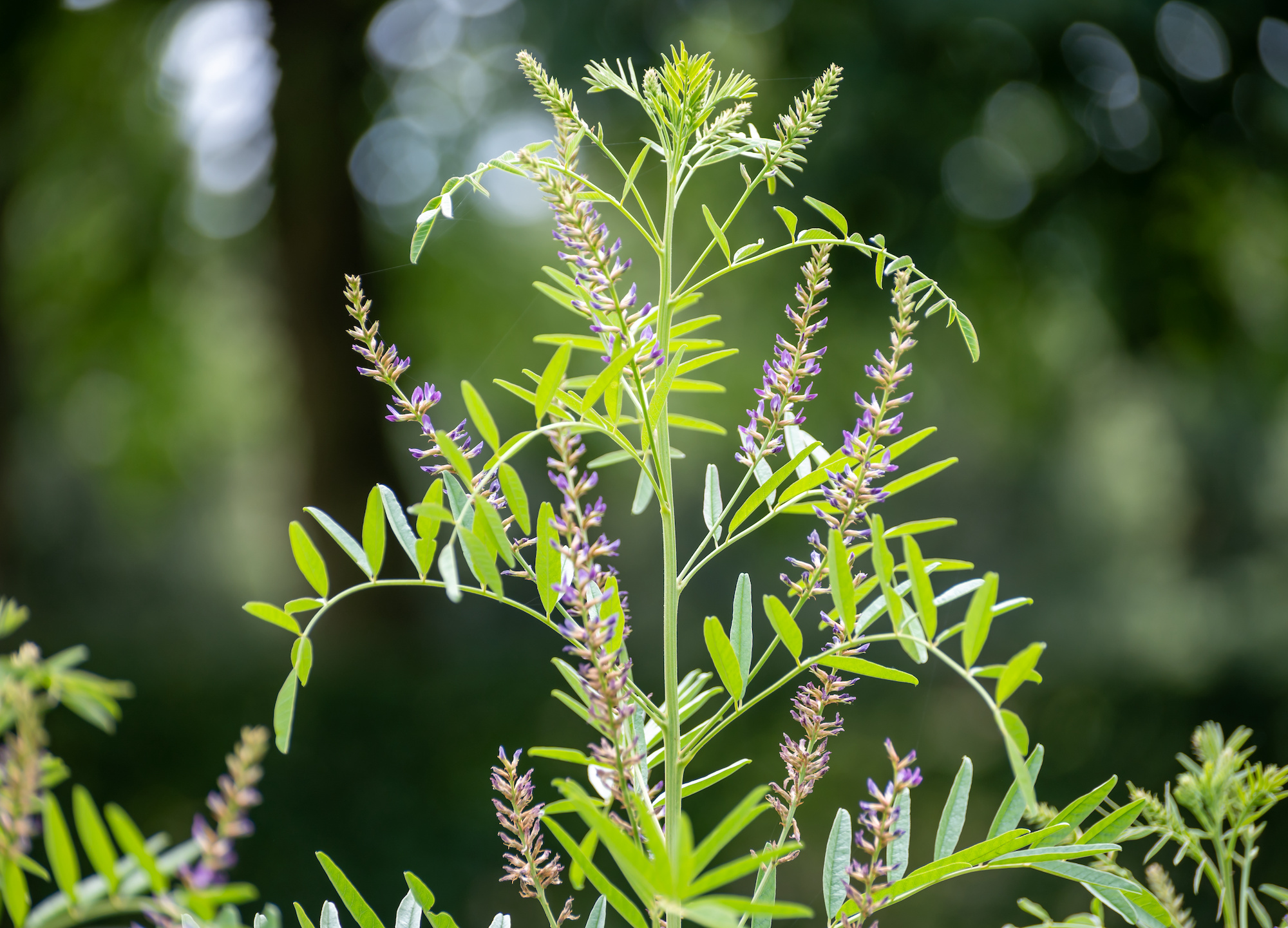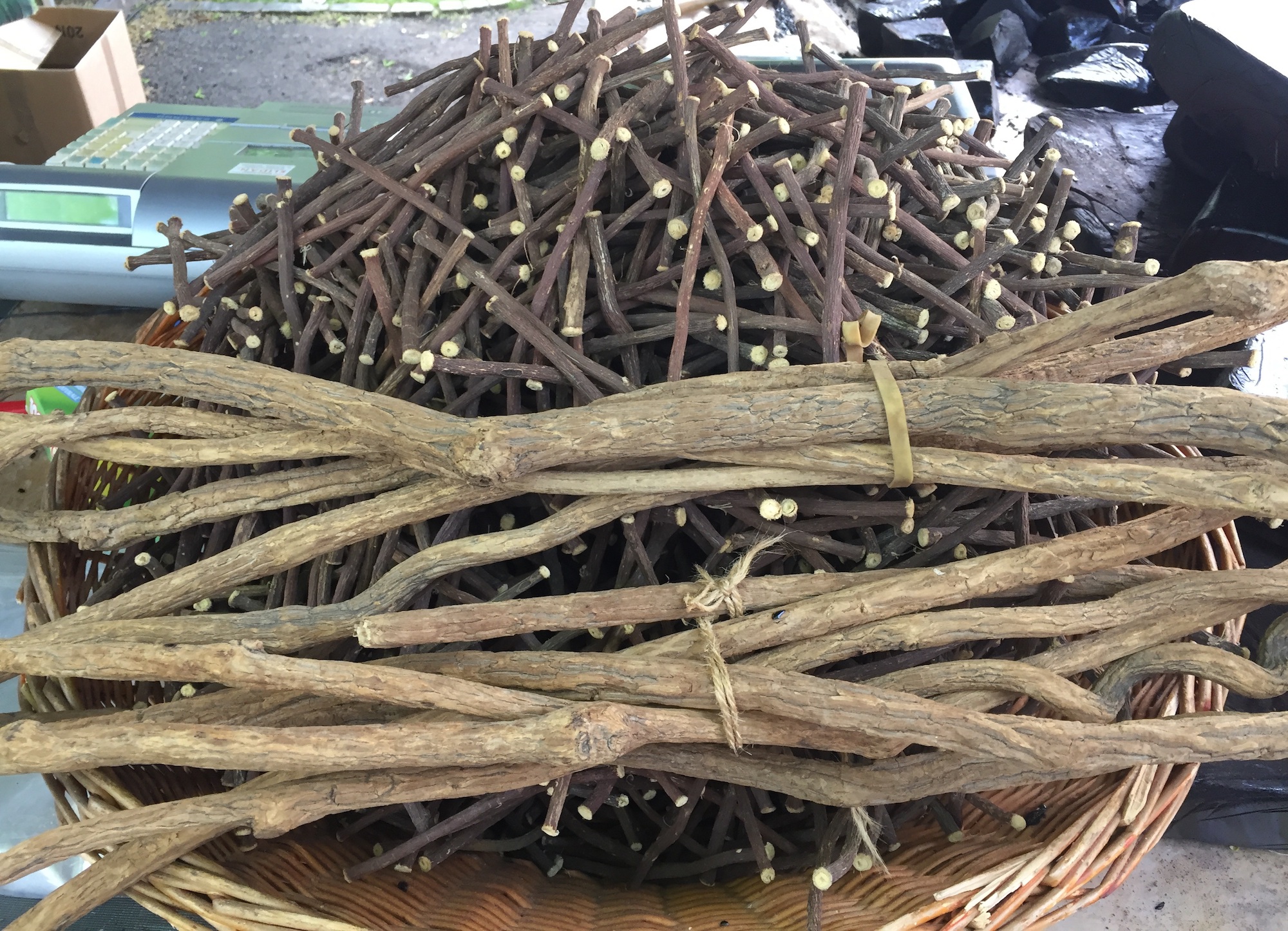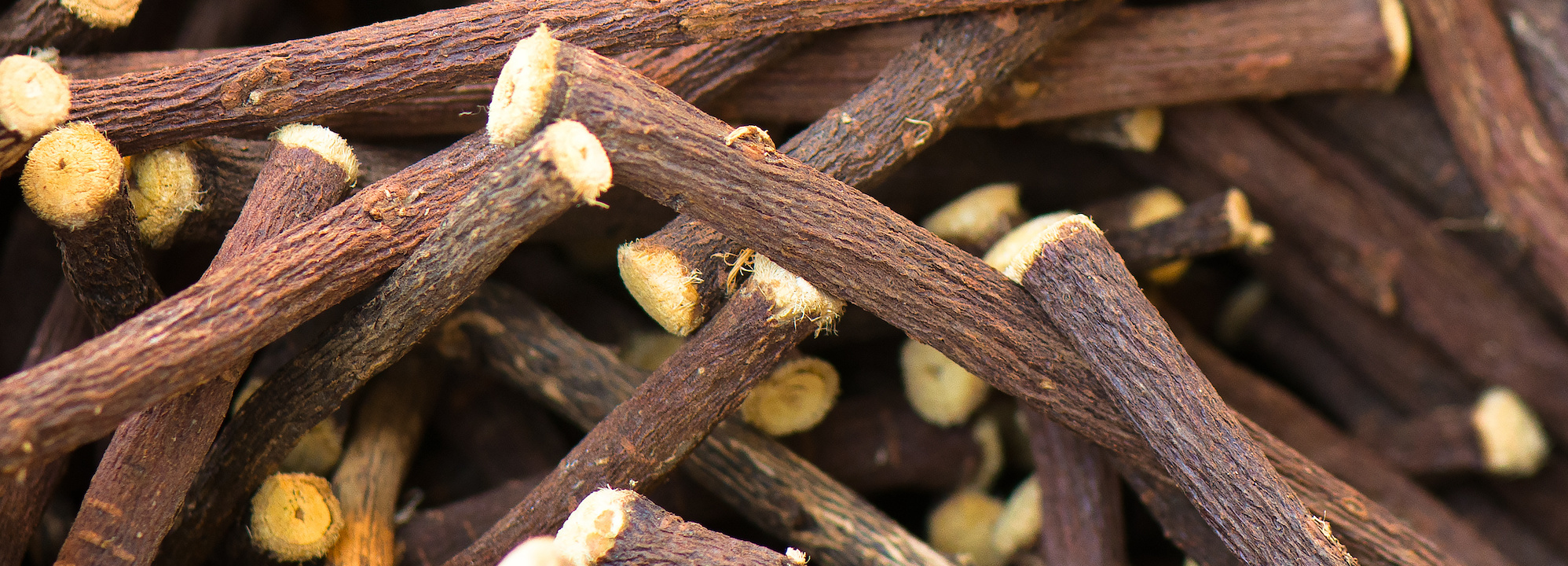Glycyrrhiza glabra
ENCYCLOPEDIA BOTANICA / LIQUORICE
The term ‘liquorice-flavoured’ is often used to mean any strong aniseed flavour, but liquorice root itself is sweet, earthly and has a lighter aniseed flavour than almost all other anethole-bearing botanicals.
Description & Habitat
Liquorice or licorice—scientific name Glycyrrhiza glabra—is a member of the Fabaceae (legume) family and a relative of both carob and tamarind. The glycyrrhiza genus contains several other species that are also grown for their sweet root, like G. echinata (known as German, Russian or hedgehog liquorice) and G. uralensis (known as Chinese liquorice) which is used extensively in Chinese traditional medicine.
Liquorice is native to Southern Europe, north Africa and west Asia. The plant is tall and graceful with feathery, green foliage, and blooms of lavender-white flowers. The leaves can tend to droop at night or during drought, and perk up again at dawn.
The plant is a perennial herb, and cultivated liquorice plants are grown to maturity before they are harvested, usually in the autumn of the 3rd or 4th year. In the first years the plant puts down several deep taproots and a network of finer surface roots. When these roots are fully established the plant starts to produce horizontal runners, or stolons (underground stems) that grow outwards up to two metres from the plant. These are storage organs for sugars that will fuel the plants’ spring growth, and new shoots emerge from near their tips. It’s the stolons that are harvested and used for flavouring. They are fibrous and flexible, wrinkled and brown on the outside, and golden on the inside. They are washed, cut into lengths, and then gently dried. Finally they are cut, crushed or finely chopped, ready for use.
Liquorice root has long been used as both a flavouring and a medicine. The active compound glycyrrhizin has many promising health benefits that are being investigated by the medical community, including its role in reducing the symptoms of gastric ulcers and boosting the immune system. At moderate doses liquorice is completely safe and healthy to ingest, but people with hypertension, diabetes and cirrhosis are warned against taking large, concentrated doses and its use is not advised during pregnancy. This is because glycyrrhizin acts on the balance of mineral salts which can cause water retention and increased blood pressure.
Parts used: Root/stolons


Aroma & Flavour Profile
While not intensely aromatic, liquorice root has a long history of use as a flavouring. It has an intense sweetness with a characteristic tinge of aniseed (which becomes much more noticeable when concentrated). This sweetness comes from the compound glycyrrhizin which is said to be between 30–60 times sweeter than refined sugar. Liquorice root’s sweetness also lingers on the tounge, making it even more noticeable.
The dried root has a peculiar, earthy aroma and shares flavour compounds with anise and fennel (most notably anethole) but without their more abrasive, mentholic notes; liquorice is more soft and rounded. Anethole is soluble in alcohol, but not in water, which is why simple infusions are wonderfully sweet, but only retain a little of these aniseed flavour notes. Liquorice has been called ‘a very combinable flavour’ and indeed is welcomed into so many different drinks, foods and confectionery. It works well with citrus, mint and many love it with a pinch (or more) of salt.

Recommended techniques
*Liquorice root does not readily produce an essential oil, so steam distillation for essential oil is not recommended.
• Infusion • Tincture • Spirit distillation (gin, liqueurs) • Infused oil •
Uses
Infusions and teas
Infusion is a great way to access the earthy sweetness of liquorice, as glycyrrhizin is highly water-soluble, and the simple infusion is added to many other drinks as a sweetener. The root was even made into a sweet drink for the Pharaohs of ancient Egypt. Liquorice root tea is widely drunk for flavour, and regarded by many as a healthful tonic who use it to treat a large range of conditions. It’s a wonderful addition to herbal tea, and a useful ingredient in many of The Alembics Lab’s favourite blends (like this ruby red hibiscus flower tea).
Culinary
This sweet, woody botanical has been used to flavour and sweeten beverages for many centuries, and it’s still chewed as a mouth freshener in many European countries. It’s used to disguise the unpleasant taste of many medicines, and added to tobacco as flavouring and to keep it from drying out. Most famously it gave its name to the chewy black confectionery. The sweet treat is traditionally made from crushed or chopped dried liquorice roots that have been boiled in water. The sugary juice is then reduced to a thick consistency and rolled into sticks around 2.5cm thick. When concentrated like this it has a very sweet taste, with a hint of aniseed flavour that is often reinforced with aniseed oil. Much liquorice sold today is not pure liquorice and contains additives like molasses and treacle in addition to the amplifying aniseed.
Tincture
Liquorice root tincture is earthy and sweet with a dry, slightly bitter finish.You really do get all of the sensory effects of the root, and the anetholes come through well. We most often use alcohol at 40% ABV because it hits a nice flavour balance, but if you were after a higher anethole concentration you can use a higher ABV. It all comes down to your intent for the tincture. We often use it for sweetening up bitter herbal blends and softening out aperitifs. We have several compound tinctures featuring liquorice, which make a beautiful pick-me-up for when you’re not feeling well. It’s like having the most delicious cough remedy. Aged tinctures develop a deeper aniseed flavour, and become blacker in time.
Infused oil
Liquorice does not readily produce an essential oil, so steam distillation is not recommended. Most liquorice oils on the market will be infused oils, or essential oil 'blends' called liquorice that use another botanical like star anise as the aromatic. The infused oils are often sold for use in skincare products and cosmetics.
Spirits
In spirit distillations, liquorice root retains its distinctive flavour, and as such is both loved and hated. For this reason (and because it’s intense and has a tendency to dominate) it’s best used sparingly in gin blends to add layers of sweetness and texture. Liquorice can also be used to balance out citrussy top notes. Distilled liquorice root is known for its capacity to change the texture and mouthfeel of gin, lending a lovely rich, viscous quality. It’s sweetness lingers, so it has a long finish, and a little goes a long way.
Liquorice root is also an ingredient in Schnapps, and more recently is used in botanically sweetened Old Tom Gins (instead of the traditional sugar that’s added post-distillation).
There are many ‘liquorice flavoured’ liqueurs like absinthe, sambuca, pastis ouzo and raki, but they can get their aniseed flavour (anethol) from many different sources like anise, fennel, hyssop and star anise. Liquorice-flavoured liqueurs are generally kept at a high ABV to retain the anethole molecules in the liquid, and is why many aniseed-flavoured drinks louche when watered down. Some of the black, wrinkled olives you may come across can have undertones of anise, so the next time you find one, why not garnish a martini with one and see how it goes?
Hydrosol
We have run hydro and steam distillations of liquorice root in the Lab, and found the results to be underwhelming—likely because there are too few aromatic VOCs in the root. The hydrosol was musty, and with all sweetness missing. It was also a difficult hydrosol to keep stable without additives, so we haven’t had them analysed. In our opinion hydrosol is just not the best way to utilise the root, not when infusion and tincture and much more simple and effective methods for extracting flavour. Some liquorice hydrosols are available commercially, but often come with claims that they include flavonoids and have anti-inflammatory properties, which is confusing, as these active ingredients do not come over in hydro or steam distillations. Water extracts may do the trick so much better, so why overcomplicate things?
Perfumery
Liquorice is said bring a gourmand touch to fragrances, which perhaps means it makes them smell a little like confectionery. It's sweet, woody and slightly spicy.
References & Resources
Check out our courses



